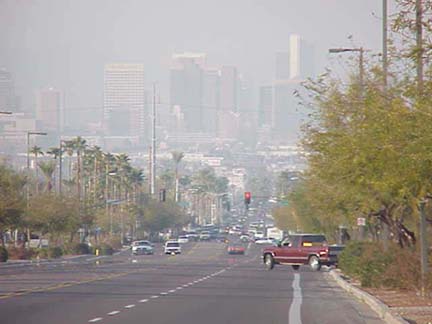
When I first moved to Phoenix,
I hadn’t suffered from an asthma attack in about four years and felt I was
out growing my asthma. After moving to the area of 43rd avenue
and Osborne (West Phoenix), I suffered two asthma attacks in the first
month and one attack a month for about six months. The doctors attributed
the recent onset of attacks to all of the pollution in the area in which I
was residing. That was about ten years ago and now residing in Glendale
I don’t have near the amount of problems breathing as I did when living
further south in the city.
For about six weeks now, I have
spent my Fridays in South Phoenix for a class I am taking at ASU. This
class is looking at South Phoenix and the effects of the new developments
and financial investments flowing into South Phoenix. In our first day of
class we discussed the location of new home developments as well as the
close proximity of downtown and the foothills of South Mountain to the
residence of South Phoenix. I must admit, the location sounded really
attractive. However, while driving there for class the following Friday, I
noticed a haze in the air over South Phoenix and all the appeal the area
had on me previously was lost.
For the past six weeks, I have felt the
effects of the pollution on my lungs after leaving South Phoenix for the
remainder of the days spent there and sometimes even the following day. I
couldn’t help but wonder why there was so much pollution concentrated in
this area. At first I thought it might just be the mountain not allowing
the air to blow through thus creating a collection site, but after a visit
to our class by Steve Brittle (a local environmentalists) I feel I have a
better understanding of the cause of all this pollution.

According to an environmental study By
ASU with sociology professors Bob Bolin and Edward Hackett, “The research
finds the higher the median household income is within an area, the less
likely those neighborhoods are to contamination sites nearby;” “ . . .
poorest neighborhoods have the highest concentration of toxic hazards.” (ASU
Insight Nov, 8 2002 ) by Lynette Summerill. Steve Brittle spoke to the
class about many different industries present and past that are
responsible for this haze as well as other pollutants found in the soil.
As interesting as this class has been as
well as eye opening, I am thankful that my Friday trips into the
air-polluted part of town have come to a close, at least for my heaths
sake. However, I can’t help but think of the poor residents that live
there seven days a week with no relief from the pollution created for the
convenience of the richer society residing north of the appalling
environment.
|